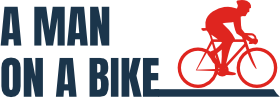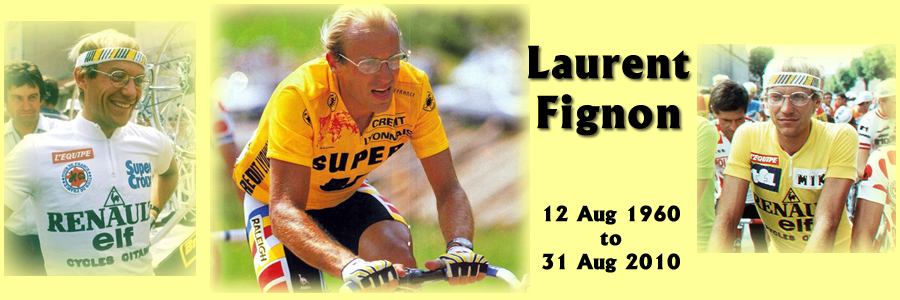August 2020 represents 60 years since the birth of Laurent Patrick Fignon and a short 10 years since his death.
Fignon (Le Professeur – The Professor), 12 August 1960 – 31 August 2010; was a French Professional Road Cycle Racer, who won the Tour de France in 1984 and 1985 and won the Giro d ‘Italia in 1989.
He nearly won the Tour de France for a third time in 1989. But was edged out by Greg LeMond by 8 seconds – the closest margin in the 117 years of the Tour de France.
Fignon was born in the Montmartre district of Paris. His first sport was Football, however his friends encouraged him into cycling and he rode his first race in 1976, aged just 16, which he won convincingly. He won 4 more races in his first year, but only one in his second year. However, he came back strongly and in his third year he won 18 out of 36 races.
Fignon was still at school, but was not a diligent student. He secured a place at University to study Structural and Materials Science. After his first year, he told his parents that he was leaving University, and going to join the Army to complete his 2 Years National Service, and then he was going to pursue a professional cycling career.
In early 1981, still an amateur, he rode the Tour of Corsica, a mixed race with both professionals and amateurs. By May, his performance had come to the attention of Cyrille Guimard, the owner of the Renault-Elf-Gitane professional Team, who offered him a professional contract for the following year.
He accepted and joined the Team in 1982 – he was just 21 years of age.
During his first year, he had a number of near misses, but managed to win the Criterium International.
In 1983, Fignon was part of the Renault team that helped Bernard Hinault win that years Vuelta a Espana. However, Fignon was not scheduled for the Tour de France. When Hinault had to pull out due to injury, Fignon was called up, with the team deciding to go for stage wins.
By Stage 9, he was in second place to Pascal Simon, who, on Stage 10 crashed and broke his collar bone, but managed to continue racing. By Stage 17 Simon had to withdraw and Fignon was the Tour Leader. Fignon managed to hold off all attackers and managed to win the Time Trial on Stage 21 – thereby winning his debut Tour de France. He was just 22 yrs. old.
By 1984, Hinault had left the Renault Team, leaving Fignon the undisputed Team Leader.
He came second in that years Giro d ‘Italia, due to the unscrupulous efforts of the media teams, who were very obviously supporting Francesco Moser, the Italian Champion.
The Tour de France that year was a battle royale, between Fignon and Hinault – Fignon eventually winning 5 stages, and winning the Yellow Jersey by some 10mins over Hinault.
In 1985, Fignon lost most of the season with two operations on his Achilles tendons. 1986 was also a poor year, having to retire from that years TdF on Stage 12.
Fignon returned to full strength in 1987, finishing third in the Vuelta and seventh in the Tour. He won the Milan-San Remo in 1988, but had to abandon the Tour.
The 1989 Tour de France battle, between Fignon and Greg LeMond, will go down in history as one of the best Tours, ever! Fignon had started the season well, winning both the Milan-San Remo and the Giro d ‘Italia.
The yellow jersey had changed hands at least 6 times between Fignon and LeMond by the time they arrived at the final stage – a short Time Trial. Fignon was leading by 50 seconds, and for any chance to win, LeMond would have to be riding 2 seconds per kilometre faster than the best time trailer in the world.
LeMond rode a very fast time trial, using aerobars, a tear drop helmet and disc wheels. Fignon had developed saddle sores after Stage 19 and was not sleeping very well, and lost 58 seconds on the stage, coming in third, but losing the Yellow Jersey to LeMond by the infamous 8 seconds. Losing the TdF was something he never really got over.
Although, he came back from the Tour and won numerous Time Trials, including the Grand Prix des Nations.
1990 to 1993 were poor years for Fignon, with only a couple of stage wins in the Tour. His last win was in 1993, at the Ruta Mexico, and he retired as a professional cyclist in late 1993.
Fignon tested positive for amphetamines in 1987 at the Grand Prix de Wallonia, subsequently disqualified. And again at the Grand Prix de la Liberation in Sept 1989.
In his autobiography, he admitted taking recreational drugs, and occasionally using stimulants in the 1980’s. He noted also, that in the early 1990’s cycling was taking huge amounts of Human Growth Hormone and the blood booster EPO. He says that this so revolted him, he gave up the sport as he realised, there was no longer a place for him.
After his retirement, Fignon worked with a number of teams, and organised a number of races, including the Paris-Nice.
In June 2009, he revealed that he was undergoing treatment for mestastic cancer, by July 2010 his cancer was widespread, and he died on the 31st Aug 2010. He was 50 years old, he was survived by his wife, and both his parents. And also his son and daughter from his first marriage.
Former champion Greg LeMond said of him: “I believe he was also one of the generation that was cut short in the early nineties because he was not able to fulfil the rest of his career. But he was a great rider.”
We were young and carefree. (The title of his autobiography.)

